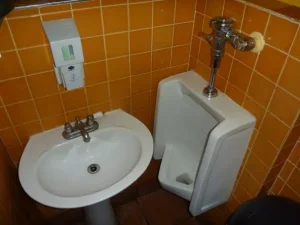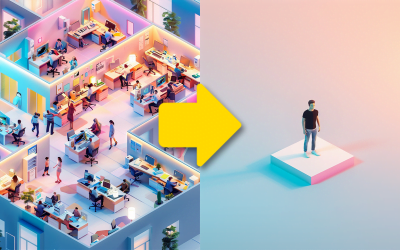I recently spoke to the seniors in Arizona State University’s Visual Communication Design department, and was asked the same question I’m asked almost every time I’m speaking to design students:
“What do you look for when hiring designers?”
(I should mention that I regard “Designers” as a broad and inclusive category. At any given time, our Creative Services team might include UX designers, content strategists, information architects, print designers, illustrators, copywriters, and so on. I actually consider them all to be designers; they simply happen to work in different media. A copywriter is a designer who works with words, for example.)
It’s a good question, and I have a simple answer. Sometimes I actually feel bad that I don’t have a clever 7-point checklist, or a heavy philosophical statement, but when it all comes down to it there’s really only one thing I actually need to see when evaluating a designer.
Anyway, the one thing I look when hiring designers is this: Empathy.
That’s it.
Using an empathy-first approach to evaluating candidates, I can usually weed out a candidate for a design job in 15 seconds or less. To be perfectly honest, sometimes I don’t even need to look at the portfolio.
Why Empathy?
Unfortunately, empathy is the characteristic I find least often when recruiting designers. That drives me a little crazy because it should be the one thing I see in every designer.
You see, design isn’t art. It’s not about self-expression and personal preference. It’s not about making things pretty.
Design is fundamentally a problem-solving discipline, and you can’t solve a problem unless you first understand it. In the world of design, empathy is the process of understanding the problem being solved and the people for whom you’re solving it.
There’s a photo I love that helps illustrate this.

This bathroom, documented by Business Insider deputy editor Sam Ro, was found behind an Italian restaurant in South Beach, Miami, Florida. In it, they mounted the urinal facing the side of the sink, and they’re literally just inches apart. You can’t actually stand in front of the urinal, because that’s where the sink is. You have to pee into it sideways, hopefully missing the sink itself.
The functional requirement for this bathroom was that they need a sink and a toilet, and the standard convention was to install a standard version of each in the normal place based on plumbing connections.
This solution passes the “I did what you told me to do” test, but doesn’t pass the higher test of actually creating a usable experience. In this case you’d either have to have Robin Hood-level aim or be willing to climb into the sink, neither of which are particularly probably assumptions. I’m guessing at least some of this bathroom’s visitors just give up on the urinal entirely and pee into the sink itself. I wouldn’t blame them.
This scenario is pretty ridiculous of course, but not as ridiculous as you might think. I see the equivalent of this bathroom arrangement on a regular basis when evaluating designers’ portfolios.
Example #1
Here’s an archetypal email I usually see several times a week:
To whom it may concern:
My name is [name] and I am a Graphic Designer. I recently graduated from [university].
I’m interested in any open positions you might have available. I would really enjoy working at a company like [company].
I have attached my portfolio and resume for your consideration.
This email approach looks perfectly professional on the surface, and is in line with what students are (unfortunately) coached to do when they graduate and start looking for a job.
However, an email like this already tells me that the candidate has an empathy problem.
I sort through a lot of interested job candidates, and every time an email comes in I’m trying to figure out:
- Who is this person?
- What are they good at?
- What are they passionate about?
- Why should I be interested in them?
But that’s exactly the kind of information people leave out of their job interest emails, because they’re afraid specificity might exclude them from an opportunity. They’re so worried about being eliminated that they don’t say anything that might help me select them.
If they had just mentioned what they were passionate about, what they were good at, etc., they’d have significantly better luck getting noticed. Even if they weren’t a good fit for our team, it would help me know who I could send their resume onto at another company.
A generic email like this is a red flag because it demonstrates a failure to think through the needs and wants of the recipient—and I have to assume those are exactly the same kind of clunky emails they would wind up sending to our clients.
Example #2
This problem of failing to express what makes you unique and relevant applies to portfolios as well.
Designers often throw absolutely anything and everything (illustrations, photography, print design, UX design, etc.) into their portfolio, hoping something will grab the eye of the reviewer. Unfortunately, this approach actually saps the strength out of the portfolio, and makes it look as if the designer isn’t particularly interested in anything. Who would want to hire a designer who’s not interested in anything?
If I’m looking for an illustrator, for example, I want to see a portfolio from someone who’s obviously excited specifically about illustration, not from someone who has three illustration examples in a portfolio with twelve other kinds of content.
Be who you are. Say what you do. Show what you love. Tell me what I should hire you for, and what I shouldn’t. That’s how you can best show empathy not just for the hiring process, but as a skill you possess in general.
Example #3
At some point in the history of the design industry, someone thought it would be really cutting-edge and sexy to put text in an unreadably small font. While the rest of the industry seems to have moved on in favor of highly legible typography—a fact for which I’m very grateful—there does seem to be a lingering notion in some design schools that the ideal font is something like 6pt Helvetica, crammed into tight little blocks that the designer can easily move around as an aesthetic element in a field of white space as big as Montana.
Similarly ineffective is the portfolio full of “lorem ipsum…” filler text. Mind you, the problem isn’t that these are sample projects instead of real ones (as is often the case with design students), but rather that they assumed the visual aspects were the part of the design that mattered most. They’re not. Visual design serves the message, not the other way around. The effectiveness of the visual design can be measured by how clearly and vividly it communicates the content it holds.
In both these cases, the message itself is treated simply as an aesthetic building block, which means that the designer has entirely skipped the most important part of the design thinking process: considering what their client is trying to communicate (empathy) and how the client’s customer will receive it (more empathy).
In the real world, design is a complicated dance between different disciplines: designers, content strategists, copywriters, developers, etc. They need to respect each other, and understand the importance of the roles they all play. I don’t need to see great copywriting in a designer’s portfolio, but I do need to see that the message matters to them as much or more so than the aesthetics. If I open a portfolio and see “edgy” but illegible text, they’ve already failed the empathy test.
It Takes Only a Few Seconds
I feel bad sometimes about how quickly I evaluate designers. When I open a portfolio PDF, scroll through it for a moment, and then think “Nope, not this one,” I sometimes ask myself if I’m just being excessively judgmental. I should give them a chance, right? I should take the time to soak it all in, absorb the entire portfolio experience, etc., shouldn’t I?
But then I remind myself that this is how design works in the real world. I’m looking for great people who understand that the role of a designer is to empathize with the client and with the client’s customers, and to solve their real-world problems in clear, powerful ways that can be quickly understood.
The best way to spot a great designer is not through a dazzling interactive portfolio experience, or through gorgeous visual concepts, or even through examples of the latest and greatest design trends.
Instead, the best way to spot a great designer is simply by observing how empathetic they are in their communication, delivery, and execution of the work. If I can find real empathy in a designer, the rest of the skills are usually teachable. (And if they have a genuine desire to understand and solve problems, they typically learn fast, too.)




